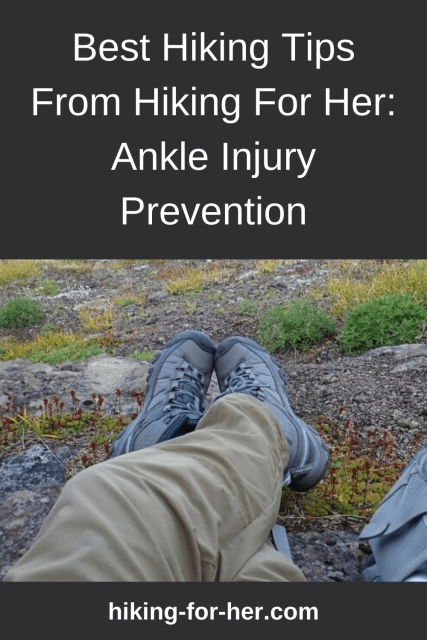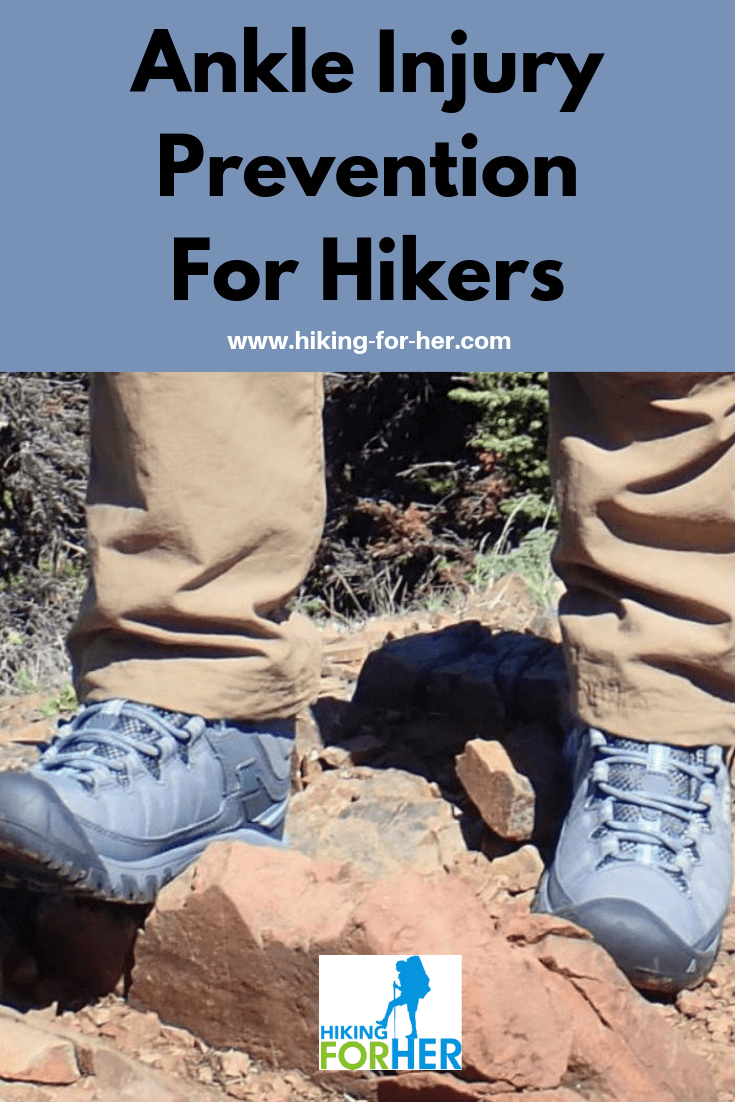
Ankle Injury Prevention Tips
To Keep Your On The Trail
By Diane Spicer
Ankle injury prevention for hikers is a big deal.
And it should not be a matter of luck.
There are many things you can do to protect your ankle joints as they endure the pounding of walking while load bearing (carrying a pack or a baby carrier up a trail, for instance).
And if you have sore ankles after a hiker, you've got some work to do!
The first thing to do
Job number one:
- Understand the marvelous talocrural joint, affectionately known as the ankle joint.
It's built around one bone called the talus, doing double duty: the talus joins the bones of the calf area (tibia and fibula) with the other foot bones.
It's the talus bone which distributes the weight of your body and whatever you're carrying to the bones beneath it in your foot.
I find it particularly cool that "talus" is also a geology word to indicate the jumbled rock pile found at the bottom of a steep slope.
- Some of my favorite hikes involve using my talus bones to cross talus slopes, because that's where pica and marmots live!
 This marmot is in no danger of a hiking ankle injury as she sits in a talus pile! But you might be, if you stumble while taking her picture.
This marmot is in no danger of a hiking ankle injury as she sits in a talus pile! But you might be, if you stumble while taking her picture.However, talus slopes can be dangerous to ankles, given the tendency of loose stones to slide beneath the weight of a hiker.
It's your ankle joint which allows you to navigate these uneven surfaces, or to recover from stepping into a hole, and generally to give you mobility along the hiking trail.
Ever notice how your elbow and knee joints only bend like a hinge, not swivel around like the ankle?
Each joint is designed for a specific purpose, and in a highly mobile joint such as your ankle, you want to prevent injuries and retain full mobility so you can keep hiking.
Common ankle injuries
for hikers -
and what to do about them
Hikers bear a lot of weight from full backpacks, heavy water bottles, carrying children or babies, or having a bit of extra body weight.
Some ankle injuries are very common for hikers, so let's take a look at those now.
Twisted ankle
A common ankle injury on the hiking trail is a "twisted" or "sprained" ankle.
You haven't twisted the bones, but rather the soft tissue which is associated with this area joining the leg and the foot.
- Ligaments hold bone to bone, and they can be "maxed out" by sudden or extreme movements (such as stepping into a hole while crossing a talus slope).
When ligaments "tear", your ankle becomes inflamed as a protective response to deal with the injury:
- pain tells you to stay off it,
- swelling and heat and redness indicate that the body is flooding the area with chemicals and cells in a protective programmed inflammatory response to heal the ankle injury.
Time to get off the ankle and apply RICE:
- Rest
- Ice
- Compression
- Elevation whilst you contemplate better ankle injury prevention strategies ;)
Be proactive:
Keep yourself off crutches by warming up before each hike: stretch your calf muscles, do some ankle rolls before lacing up your boots, make sure your entire body is loose and limber before tackling a steep section of the trail.
Strained ankle
You may also hear about ankles strains.
These are different than sprains because it's the tendons of the muscles joined to the bone, not the ligaments, which are torn.
You will be facing a longer recovery time, because that area is not well served by the circulatory system.
For a complete litany of ankle injuries, read this.
Ankle injury prevention:
pre-emptive stretching
Which brings us to another good reason for warming up before you hit the trail:
- to keep your muscles stretched and less prone to pulling their anchoring fibers (tendons - more on this in a bit) off the bone.
Ankle injury prevention shouldn't be confined to a few minutes at the trail head, however.
Here are a few tips for incorporating ankle care into your daily routine.
- When you're lying in bed in the morning, point your toes away from, and back toward, your body. Ah! Feel that glorious stretch?
- Make it a practice to rotate each ankle in both directions while you're in the shower (just not simultaneously!).
- As you sit on the bus or endure a long meeting, wiggle your ankles and let some blood get down to your ankle joint by uncrossing your legs.
- Loosen your tightly laced shoes at every opportunity.
- Do some "on your toes" exercises when you walk up a staircase - pause, grab the railing, and let your body weight provide some "oomph" to give your leg muscles and ankle joint a good work out as you balance on tiptoe to the count of 10.
- While still on the staircase, put your toes on the step above and lean in to stretch the calf muscles. Feels good!
Achilles tendon self care
You have a huge piece of soft tissue that anchors your calf muscle to your heel bone, in other words in your ankle area.
It's easy to find - just grab the back of your heel and marvel at the tough Achilles heel tendon between your fingertips.
This tendon can become inflamed or torn, and that means no hiking for a long, long time regardless of how much ankle injury prevention you practice.
So while we're in the ankle area, a little self care for this tendon is in order.
Stretch your Achilles tendons
Before you start a hike, or before any activity if you want to stay on the safe side, perform a simple Achilles tendon stretch:
- Hang your heels off a step/stair and let your body weight give those tendons a nice stretch.
During a hike, when your calves feel tight, press against a stable rock or log with a flexed foot (or use a handy wall at home) to feel that same stretch.
Strengthen your Achilles tendon
for ankle injury prevention
Want the most low tech approach to strengthening your Achilles tendons for hiking?
- Jumping jacks
- Skipping around your yard or block
- Alternate between these two moves, and if you feel silly, do it anyway!
Another thing to try: heel drops.
- Use the same step
you used for stretching, but this time, with your heels hanging off the
edge, lower yourself down and then back up.
- Don't force this motion, only go as far down as your legs are willing to go. The more you do this exercise, the lower you will be able to go over time.
- Use the stair railing to balance yourself so you can concentrate on the heel drops.
More ankle self-care tips for hikers
Ankle injury prevention is a full time job, but doesn't have to be expensive or onerous.
A bit of self care, including massage, never hurt the soft tissue of this joint!
Be sure you're wearing supportive footwear on the trail, either hiking boots or trail shoes.
- If you profess to have "weak" ankles, wear high cut boots rather than low cut trail shoes.
Compression socks with inbuilt support can help your feet perform in harmony with your ankles.
If you do nothing else: stay hydrated.
- Soft tissues get brittle and prone to injury if they don't have access to water throughout every day, and not just on hiking days.
- So give yourself plenty of water on a daily basis!
It's a brilliant idea to walk every day, on uneven terrain if possible, with elevation gains and losses, to keep your ankles up for the job of dealing with variable trail conditions.
-
Hikers who "train" by walking or running on paved surfaces aren't doing their
ankles any favors when it's time to hit the (uneven) trail.
No joke!
Well, maybe a small one...
Hiking humor is important, even when discussing ankle injury prevention.
So here's a hiker's joke for you:
Why do hikers have ankles?
- To give mosquitoes something to bite!
That, and to take us up and down the trail, hour after hour.
So ankle injury prevention just makes sense for hikers AND mosquitoes, right?
Right!
If your feet hurt after a hike, use these tips to make life easier:
- Sore feet prevention
- Hiking soreness
- What to do about toe problems
Home page > Injury Prevention >
Ankle Injury Prevention Tips
|
I get emails all the time about what I wear, eat, carry and love to use on the trail. That's
why I provide affiliate links to you: the best gear that I use myself and have seen used by other hikers is instantly
available for your consideration, and the gear company sends a few
pennies per dollar to this reader-supported hiking website. There is no added cost to you! Everyone ends up a winner: Great gear for you, strong gear companies, and more free hiking tips for everyone. Thanks very much for your support. It's warmly and sincerely appreciated. It also helps send these hiking tips to all your virtual trail buddies around the globe. |
 |



